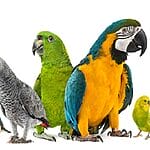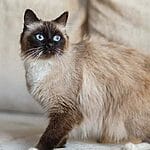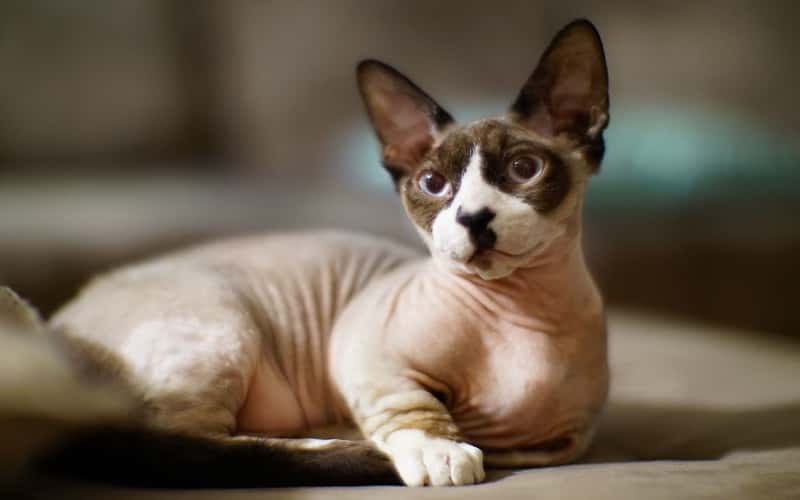Bengal Cats – Mixed Cat Breed Characteristics & Facts

Bengal cats can never be described as delicate. They are athletes, graceful and agile with a powerful, muscular body appropriate for a cat that resembles a jungle cat. Bengal cats are actually quite affectionate with their human families, despite their wild appearance. Despite this, they also have a lot of energy and a playful, fun side.
Since they want to stay active, they require a house that can accommodate their vigor. You can have a loving, intelligent cat who can keep you on your toes if you can satisfy the Bengal’s need for exercise. It’s important to keep in mind that cats of any breed may experience health problems at any time in their lives. With the right pet insurance, you can be ready to provide your cat with the care they require at any age.
Get your Bengal a pet insurance plan by clicking here! For a detailed list of Bengal cat breed traits, continue reading!
Bengal Cats Mixed Cat Breed Picture
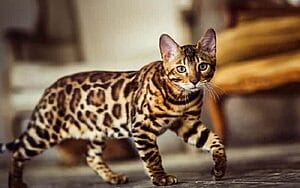

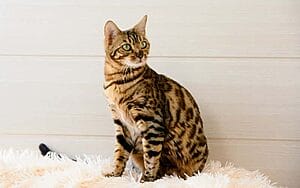
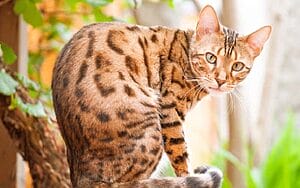
Bengal Cats – Mixed Cat Breed Characteristics
Affectionate with Family | ***** |
Amount of Shedding | ** |
General Health | *** |
Potential for Playfulness | ***** |
Tendency to Vocalize | ** |
Kid-Friendly | ***** |
Friendly Toward Strangers | *** |
Easy to Groom | **** |
Intelligence | ***** |
Pet Friendly | ***** |
Vital Stats:
| Life span: | 10 to 16 years |
| Length: | 17 to 22 inches, not including tail |
| Weight: | 8 to 17 pounds |
| Origin: | USA |
History
Although one of his ancestors was the small, wild Asian leopard cat, the Bengal is a domestic cat through and through, despite having a distinctively spotted coat and a large size that give him the appearance of a wild cat on the prowl. The scientific name of the Asian leopard cat, Felis bengalensis, is where Bengal cats get their name.
They were developed by breeding domestic shorthairs with Asian leopard cats, which were available in pet shops in the 1950s and 1960s. The first person to do such a cross was a breeder in California named Jean Mill, but she wasn’t doing it to start a new breed. So that she wouldn’t be lonely, she had bought a leopard cat and allowed her to keep company with a black tom cat.
She wasn’t expecting the two species to mate, so she was surprised when kittens appeared. Mill kept the spotted female of the litter. She gave birth to a litter of solid and spotted kittens when bred back to her father. At around the same time, Dr. Willard Centerwall of Loyola University was breeding domestic cats with Asian leopard cats.
Researchers were curious to learn if the leopard cats’ resistance to the feline leukemia virus could be passed on to hybrid offspring. The development of the cats as a breed attracted the interest of numerous breeders. There was Mill among them. She had stopped cat breeding due to changes in her life, but she was now prepared to start up again. She sought out suitable males to breed with some of Dr. Centerwall’s hybrids that she had acquired.
One was a domestic shorthair orange that she discovered in India, of all places, and the other was a brown tabby with spots that she got from a shelter. Bengals are now regarded as being identical to domestic cats, so it is recommended that any Bengal purchased be at least four generations removed from any ancestors who had wild bloodlines.
The International Cat Association was the first cat organization to officially recognize the Bengal breed, giving it experimental status in 1983 and full recognition in 1991. The United Feline Organization, the Canadian Cat Association, and the American Cat Fanciers Association all recognize the Bengal. Bengal cats are so prized that a British woman paid more than $50,000 for hers in 1990, referring to them as the “Rolls Royce” of feline companions. Bengal cats are extremely rare.
Size
It’s a medium-sized to large cat. Bengal cats can weigh up to 15 pounds.
Personality
The Bengal is a very intelligent and active animal. He can be difficult at times, but this makes him enjoyable to live with. Overall, the Bengal is a self-assured, chatty, sociable, and watchful cat. He notices everything. He enjoys playing games, such as fetch, and is a pro at picking up new skills. It’s a good thing he doesn’t have opposable thumbs because his dexterous paws are almost as good as hands because he would probably rule the world.
Bengal cats that are bored may also develop some unusual (and occasionally destructive) behaviors, such as turning on and off light switches, snagging seals in drains, and gleefully removing CDs from your DVD player. The Bengal enjoys playing in the water and won’t hesitate to accompany you into the shower or tub. He may endanger pond and aquarium fish with his cunning paws.
He also enjoys climbing and is frequently seen perched on the highest shelf in the house. For this cat, puzzle toys that will test his intelligence and at least one tall cat tree are necessities. The affectionate Bengal will be happy to sit on your lap on the infrequent occasions when he isn’t swinging from chandeliers or swimming in your pool. He will obviously sleep in your bed with you. He does indeed steal the covers.
Health
Pedigreed and mixed-breed cats both have varying rates of health issues that could be genetic in origin. Although Bengals generally have good health, the following ailments have been reported in the breed:
- Distal neuropathy is a nervous system condition that makes people feel weak. Bengals can develop it as early as the first year of life. Fortunately, many cats bounce back on their own, though occasionally they do.
- Flat-chested kitten syndrome is a birth defect that can range in severity. When they are mature, kittens who live to adulthood typically don’t exhibit any signs.
- Hip dysplasia, which can become lame in severe cases
- A heritable form of heart disease in some breeds is hypertrophic cardiomyopathy.
- Patellar luxation is a mild to severe hereditary dislocation of the kneecap. Surgery can be used to treat severe cases.
- Degenerative eye disease known as progressive retinal atrophy.
No matter how healthy your cat initially appears to be, you should be ready for any problems that might arise over the course of their lifetime. You can be prepared for any veterinary needs your cat may have with the aid of a pet insurance policy.
Care
The Bengal’s short, dense coat requires only weekly combing to remove dead hair and distribute skin oils. Rarely is a bath necessary. To prevent periodontal disease, brush your teeth. Although daily brushing is preferred, once a week is still preferable to never. Twice a month, trim your nails. To get rid of any discharge, use a soft, damp cloth to wipe the corners of your eyes.
To prevent the spread of any infection, use a different area of the cloth for each eye. Each week, check your ears. If they appear to be dirty, clean them with a cotton ball or soft, damp cloth dipped in a 50/50 solution of warm water and cider vinegar. Cotton swabs shouldn’t be used because they can harm the ear’s interior. Maintain a spotless litter box.
Cats are extremely picky when it comes to bathroom hygiene, so a filthy litter box might make them start using other areas of the house instead. A Bengal should only be kept indoors to prevent him from contracting illnesses from other cats, being attacked by dogs or coyotes, and other risks that face cats who go outside, like being hit by a car. Keeping him inside also safeguards neighborhood wildlife and birds from this hunter.
If at all possible, construct a sizable outdoor enclosure for your Bengal so that he can jump and climb securely. Bengals who venture outside also run the risk of being taken by a person who wants to own such a stunning cat without having to pay for it.
Coat Design and Maintenance
Bengals can never be described as delicate. He has a strong, muscular body and is athletic, as befits a cat that appears to belong in the jungle. He is also graceful and agile. His broad head has rounded edges and a modified wedge shape that is longer than it is wide. It has medium-sized to small, relatively short ears that are positioned to the side of the head. Nearly round eyes with an oval shape.
A long, muscular neck connects the head to the body. Medium-length legs with large, rounded paws that are slightly longer in the back than the front support the body. A thick, medium-length tail with a black tip tapers at the end. A Bengal’s spotted belly is another characteristic that is visible when it rolls over. The Bengal’s short, thick pelt, which is luxuriously soft and silky to the touch, adds to its wild appearance.
It is available in a variety of hues and patterns, such as brown tabby, seal silver lynx point, black silver tabby, and seal mink tabby. The coat can be marbled, with horizontal stripes placed randomly on a lighter background, or it can be spotted randomly or in horizontal patterns. The coat of some Bengals is referred to as “glittered.” The fur appears to be dusted with gold dust as it shimmers in the light.
Kids and other animals
For households with young children and canines who get along with cats, the energetic and sociable Bengal is ideal. He can play fetch just as well as any retriever, picks up new tricks quickly, and enjoys the attention from kids who are kind to him. He is aware enough to avoid toddlers, but he prefers school-aged kids because they match his enthusiasm and curiosity.
Nothing terrifies him, especially not dogs, and if they don’t bother him, he will happily make friends with them. Always introduce new pets slowly and in a supervised environment, even other cats. Bengal cats, like many other active cats, have a high prey drive and shouldn’t be trusted around smaller prey animals like guinea pigs, smaller rabbits, and hamsters.
Creator: PetsCareTip



